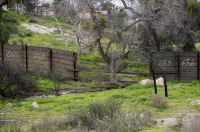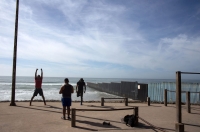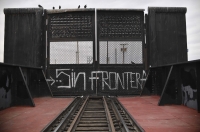The monumental divide
With debate raging in the United States and Mexico over President Donald Trump’s plan to build a wall along the nations’ border, AFP photographers decided to take a closer look. Just what did this border look like? What did the people living and working there think?
So they took 10 days to drive nearly 1,750 miles along the border. Jim Watson, based in Washington, drove on the US side from California to Texas. Guillermo Arias, based in Tijuana, drove on the Mexican side from Baja California to Tamaulipas with Yuri Cortez, based in Mexico City, joining him along the way.
They found drug cartel-inspired fear on the Mexican side, an eerie quiet on the other. Endless desert and farmland stretching to the horizon. Signs of migrants, but, aside from one woman with a baby, none in sight.
They saw Americans crossing into Mexico for cheap medical care and medicine and Mexicans crossing into the US to labor on farms. Teenagers recording music by the river. People deported from the US who lived close to the border because their families remained on the other side. One guy walking along the highway with his dog was thinking of not stopping until the east coast.
They found much apprehension about the proposed wall on both sides of the border. And at times an imposing fence and barriers snaking along much of the frontier.
An eerie dead zone with few souls in sight
By Jim Watson
From everything I had read and heard about the US/Mexico frontier, I envisioned this porous border area where migrants were going across by the dozen all the time. I thought I was going to see people running across on a daily basis. In my 10 days there, I didn’t see a single one.
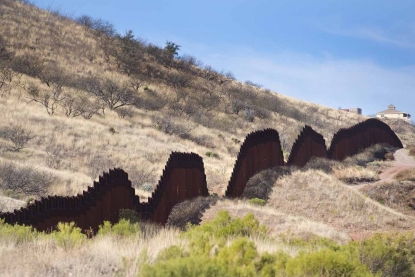 A section of the border fence in Nogales, Arizona.
(AFP / Jim Watson)
A section of the border fence in Nogales, Arizona.
(AFP / Jim Watson)In fact, I didn’t see much of anyone. (Except for one guy with his dog who decided to walk from Texas to California and back pulling a wagon, but more on him later).
One of the things that struck me about our side of the border is how eerily quiet it was. It was like a dead zone. I kept complaining to Guillermo and Yuri that you guys got all that beautiful scenery, the people. On our side, it’s a real dead zone, there’s nobody there. During the 10 days that I spent shooting, I was stopped routinely by the Border Patrol and asked what I was doing there. So if you don’t have any business there, you’re likely to get stopped very quickly. I remember one scene on the beach at Border Field State Park outside of San Diego, right at the start of the trip -- there were 20-25 people on the Mexican side and on my side nobody. I had a few days when I didn’t talk to anyone. In the end, it turned out to be a pretty lonely assignment.
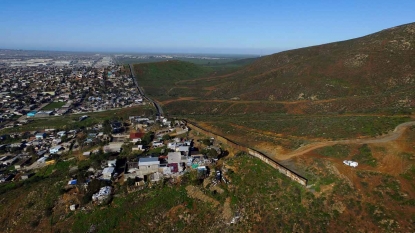 The border on the outskirts of Tijuana.
(AFP / Mario Vazquez)
The border on the outskirts of Tijuana.
(AFP / Mario Vazquez)I got the idea for this story because I had no precise idea of what the border between the two countries looked like. Most Americans don’t. I didn’t realize how much of a border barrier we have already. Across much of the frontier, it’s a rolling fence and the expanse of it already is amazing. People talk like there is nothing there, but a significant amount of the border is sealed off. Especially around the major population centers.
When I first got the idea for the project, I envisioned driving along the border on the US side. My boss had a better idea -- to have my colleagues in Mexico do the same thing on the other side.
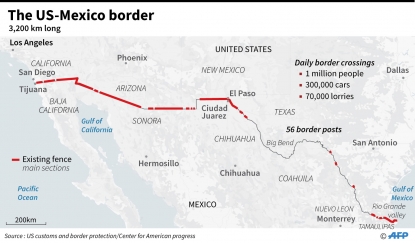 (AFP Graphics)
(AFP Graphics)This story for me, as an American, was difficult at times. On the one hand, you want proper border security for your nation. On the other hand, you feel that everyone deserves a chance at prosperity and a better life. This idea of the American dream is woven into the fabric of the country, it’s what we grow up with. From the pilgrims who landed on Plymouth Rock, to the pioneers who pushed out West, to the waves of immigrants landing on Ellis Island to people who have reached the heights of success from ordinary or obscure beginnings (think Bill Gates, Mark Zuckerberg, Presidents Bill Clinton and Barack Obama), everyone deserves a shot at making it.
At one moment during the trip, I glimpsed a bit of the desperation that drives people to cross. It was during day three and I had just got to the Imperial Dunes, in California nto far from the Arizona border. It was about a mile from the road to the border fence, where there was a construction crew doing some work. I thought it would make some nice pictures, so I walked out there.
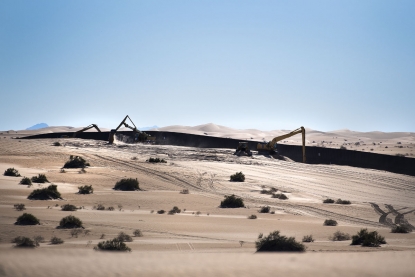 Imperial Sand Dunes, California, February, 2017. (AFP / Jim Watson)
Imperial Sand Dunes, California, February, 2017. (AFP / Jim Watson)Going out, I stayed in the tracks of the heavy machinery, but even so, my feet were sinking into the sand. Once I shot my pictures, I turned around to walk back to my rental car. The walk back was worse -- my feet sank about six inches with every step, I was drenched in sweat and I had forgotten my water in the car.
And that’s when it hit me -- this is what it must be like for a migrant, I thought. All I had was two cameras, while many of them would be carrying children and their belongings. I had just hiked for two miles, while they had to walk across the unforgiving desert for so much more. I knew that my water bottle was waiting for me in the rental car; they didn’t know where their next water would come from.
How could anyone want to do this, I thought to myself. They must be mad or completely desperate. Noone would do this just to do it, they really have to have a good reason and that should count for something. You could say that I walked a mile in their shoes. Almost...
The surroundings around the border are really unforgiving, which also helps drive home the point of the desperation of the people trying to cross. Much of it is desert and at times it’s so endless that it seems to engulf you.
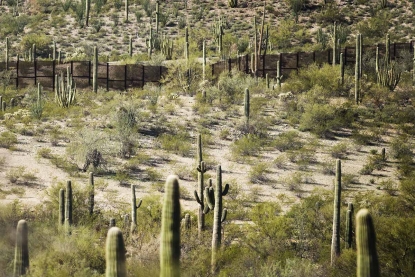 Organ Pipe Cactus National Monument near Lukeville, Arizona, February, 2017.
(AFP / Jim Watson)
Organ Pipe Cactus National Monument near Lukeville, Arizona, February, 2017.
(AFP / Jim Watson)At one point, I stumbled onto what’s called by Border Patrol a migrant oasis. It had water and candles and was meant to help those that had no water or anything else as they crossed the desert.
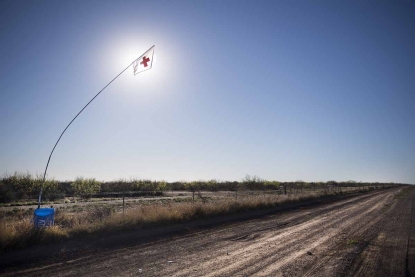 A barrel with water on a dirt road near the US/Mexico border outside Eagle Pass, Texas, February, 2017.
(AFP / Jim Watson)
A barrel with water on a dirt road near the US/Mexico border outside Eagle Pass, Texas, February, 2017.
(AFP / Jim Watson)The other thing that struck me were the migrant workers. I talked to some of them as they were getting off the bus in San Luis, Arizona. One guy told me that he woke up every day at 2 am, crossed the border, got in line by 4 am to get onto a bus to be taken to work, mainly on lettuce farms. He works for 10 hours a day, for 10 dollars an hour. He returns to the parking lot around 5 pm, walks a half mile back to the port of entry and back to his home in Mexico around 8 - 9 pm. And he does this every single day. Can you imagine this type of life? It’s just insane.
Once I got back home, I started doing some more research on it and it turned out that a crazy number of agricultural workers in the US are migrants. I’ve read figures as high as 45 percent.
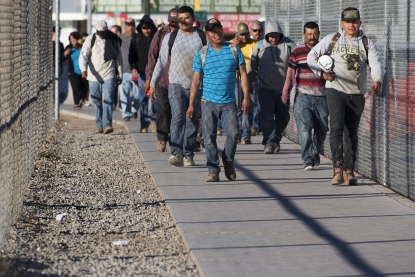 Temporary agricultural workers return to the port of entry in San Luis, Arizona, February, 2017. (AFP / Jim Watson)
Temporary agricultural workers return to the port of entry in San Luis, Arizona, February, 2017. (AFP / Jim Watson)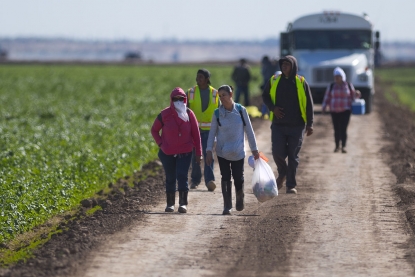 Temporary agricultural workers walk off a lettuce farm at the end of their shift outside Yuma, Arizona, February, 2017.
(AFP / Jim Watson)
Temporary agricultural workers walk off a lettuce farm at the end of their shift outside Yuma, Arizona, February, 2017.
(AFP / Jim Watson)
Some of the things that I discovered seemed just odd to me. Like a plastic statue of a wise man praying over the plastic statue of baby Jesus outside of Nogales, Arizona. That was strange to me. I kept finding these religious items in the strangest places throughout the border.
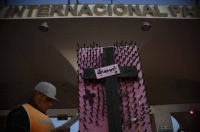
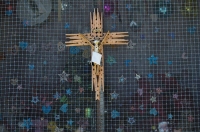
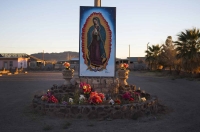
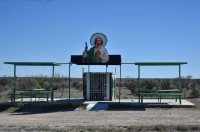
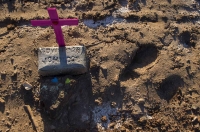

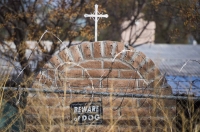
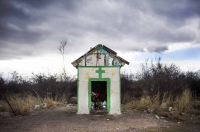

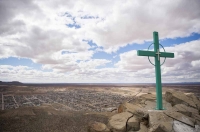
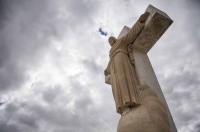
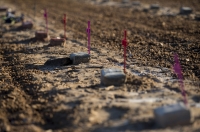
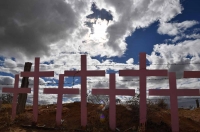
One of the strangest encounters that I had on the trip was Chris Kirkland, a self-proclaimed nomad. I spotted him walking down the highway pulling a wagon with his dog outside Columbus, New Mexico. I got out and talked to him for a while. He told me that he had walked from Dallas, Texas to San Diego, California and was now on his way back to Dallas, but could keep going to the East Coast. When I asked him why, he said he just felt like walking for his health. (It reminded me of the Forrest Gump movie, when Gump said that he just felt like running, so he ran across the country). Chris was a very jolly guy and talked about surviving lightning storms and rain and heat waves, all the while camping with his dog.
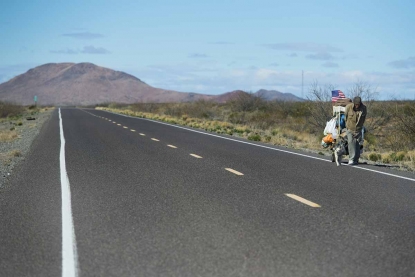 Self-proclaimed nomad Chris Kirkland walks along Country Road B002 outside Columbus, New Mexico, on February 19, 2017, near the US/Mexico border.
(AFP / Jim Watson)
Self-proclaimed nomad Chris Kirkland walks along Country Road B002 outside Columbus, New Mexico, on February 19, 2017, near the US/Mexico border.
(AFP / Jim Watson)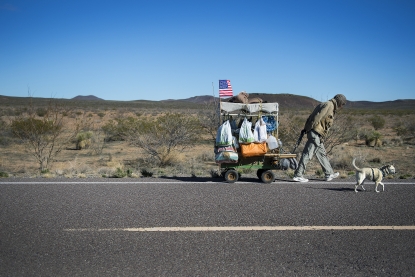 Self-proclaimed nomad Chris Kirkland walks along Country Road B002 while on a cross-country hike outside Columbus, New Mexico, February 19, 2017, near the US/Mexico border. (AFP / Jim Watson)
Self-proclaimed nomad Chris Kirkland walks along Country Road B002 while on a cross-country hike outside Columbus, New Mexico, February 19, 2017, near the US/Mexico border. (AFP / Jim Watson)
The border fence ranges from an imposing wall, to wire fencing or knee-high barriers that you could easily step over.
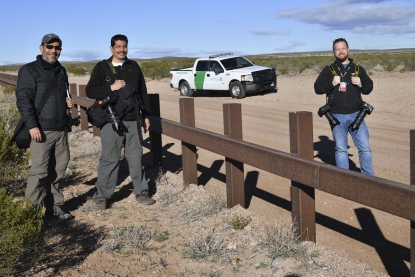 (L-R) AFP's photographers Guillermo Arias, Yuri Cortez and Jim Watson are pictured at metal fence between US and Mexico in Puerto Palomas, Chihuahua state on February 19, 2017. (AFP / Yuri Cortez)
(L-R) AFP's photographers Guillermo Arias, Yuri Cortez and Jim Watson are pictured at metal fence between US and Mexico in Puerto Palomas, Chihuahua state on February 19, 2017. (AFP / Yuri Cortez)Outside of El Paso, the border is just monstrous, the fence is crazy, it seems like Mexico itself is in jail.
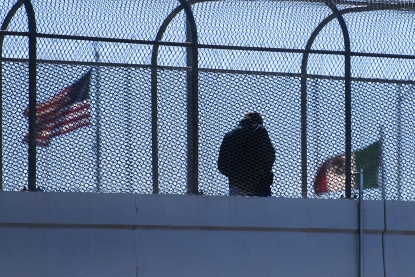 A man crosses the footbridge to Juarez, Mexico, from El Paso, Texas, February, 2017.
(AFP / Jim Watson)
A man crosses the footbridge to Juarez, Mexico, from El Paso, Texas, February, 2017.
(AFP / Jim Watson)Outside of major population centers the border is very secure. But there’s definitely holes and gaps and obviously people do cross, even though I didn’t happen to see any. At one point, I was hanging out with Border Patrol agents and they were observing a group on the other side of the border that they felt would try to cross soon. They had multiple eyes on them and they told me that if I hung around long enough, I could witness it. But I sat there for three hours with one guy and three hours with another guy and I had to keep moving.
Most agents whom I met told me that they didn’t want a wall, they preferred having a fence on the border because that way they could observe the other side and know what was coming at them.
The Border Patrol has an amazing array of tools for monitoring the border and the surrounding area. It includes a TARS, a Tethered Aerostat Radar System, a huge blimp that hangs 10,000 feet in the air and is said to see everything around it for miles.
On the river, the agents use fan boats. These act mostly as a deterrent -- they are very loud, so when the illegals hear them coming, they leave the area to avoid being arrested.
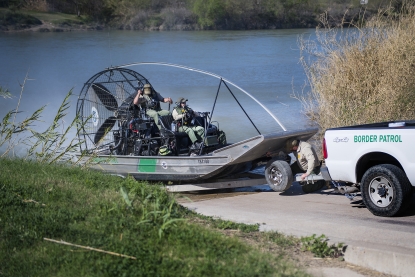 US Border Patrol pull outs of the Rio Grande river on a fan boat on the US/Mexico border in Eagle Pass, Texas, on February 21, 2017. (AFP / Jim Watson)
US Border Patrol pull outs of the Rio Grande river on a fan boat on the US/Mexico border in Eagle Pass, Texas, on February 21, 2017. (AFP / Jim Watson)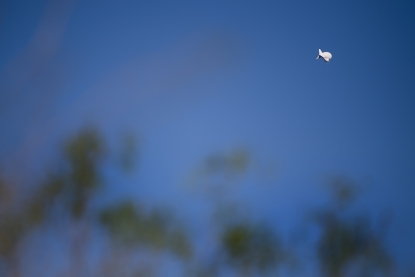 An US Border PatrolTethered Aerostat Radar System (TARS) blimp floats in the air near the US/Mexico border outside Eagle Pass, Texas, on February 22, 2017. (AFP / Jim Watson)
An US Border PatrolTethered Aerostat Radar System (TARS) blimp floats in the air near the US/Mexico border outside Eagle Pass, Texas, on February 22, 2017. (AFP / Jim Watson)
And then there are seismic tools that send signals when triggered. At one point I was hiking around with a Border Patrol agent and he got a call about a trigger, so we went to investigate. It turned out to have been an animal, which he said was quite common.
From what I could see after talking to the people on the ground, a border fence is not really needed to keep out illegal immigrants, but more for keeping out the drugs. The barrier slows down the contraband crossing the border and funnels it to locations -- the gaps in the fence -- where Border Patrol can reinforce their presence.
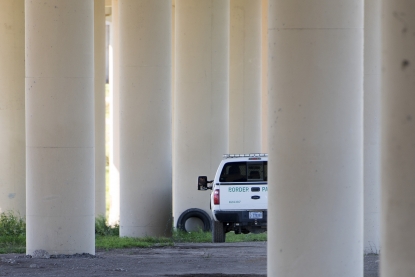 US Border Patrol sits parked under a bridge near the Rio Grande river on the US/Mexico border in Eagle Pass, Texas, on February 21, 2017. (AFP / Jim Watson)
US Border Patrol sits parked under a bridge near the Rio Grande river on the US/Mexico border in Eagle Pass, Texas, on February 21, 2017. (AFP / Jim Watson)And business owners in the towns close to the border complained that all the talk about a wall and illegal immigration has hurt business.
I have to say, this was a very satisfying assignment, on so many levels. First off, it was just informative because I learned what the border really looked like. Turns out that we have quite an extensive border fence already. When I got back, a lot of my colleagues said the same thing, that they didn’t realize that there was a border barrier already.
Then there was the reaction to it. Twitter has been going crazy. It’s very satisfying to have such feedback on your work.
And then there was the simple luxury of it all. When you work at a news agency like AFP, you rarely spend lots of time on a single story. I got to spend 10 entire days on this one. It was a pretty amazing opportunity and the time really allowed us to show how things truly are on the ground. Which is why I think the feedback has been so amazing. I hope we get a chance to do things like this again.
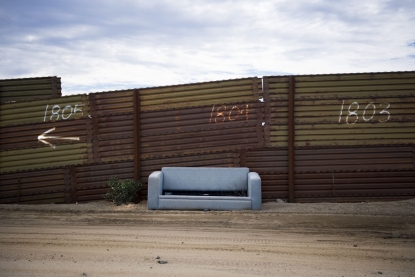 An abandoned sofa sits against the border fence on the US/Mexico border in Tecate, California on February 14, 2017. (AFP / Jim Watson)
An abandoned sofa sits against the border fence on the US/Mexico border in Tecate, California on February 14, 2017. (AFP / Jim Watson)Treading softly along the death line
By Guillermo Arias and Yuri Cortez
Yuri: When we first talked about doing the project, I thought that I would drive along the Mexican side the whole way. But I quickly realized that this would not be such a great idea. The security situation is so dangerous on the Mexican side of the border that you need someone who knows the area. That’s when I decided to bring in Guillermo. He has been living and working along the border for years, so he both knows the terrain and has contacts there. Plus he’s a great photographer. And I would join him toward the end of the trip.
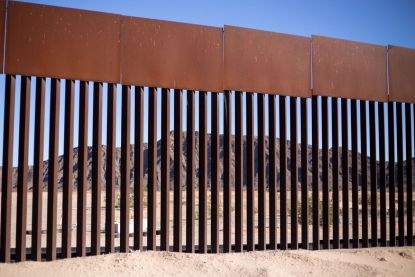 Los Algodones, Mexico, February 15, 2017.
(AFP / Guillermo Arias)
Los Algodones, Mexico, February 15, 2017.
(AFP / Guillermo Arias)Guillermo: I have been living and working on the border for 14 years and am just finishing a book on the issue, so I know much of the border, I’d been to most of those places.
The most challenging aspect for work on the Mexican side is the security of course. The drug cartels control most of the area and some territories are very disputed. They have eyes and ears everywhere. When they see someone taking pictures, they get very nervous. You have to be careful about what you are doing.
Yuri: When you arrive in a new place, it’s very important to meet with local people -- on the street, in the park -- to talk with them about the situation of the place you’re visiting. It’s very important for security. I met with one man in Nuevo Laredo, one of the most dangerous places along the border at the moment, and we were talking and he told me -- ‘now it’s very quiet, during the day it’s ok. But at night it’s very dangerous, the town is like a ghost town.”
 An old picture dating back to 1939 of the international bridge between Nuevo Laredo, Mexico and Laredo, Texas, in the parking lot of the bridge on February 22, 2017.
(AFP / Yuri Cortez)
An old picture dating back to 1939 of the international bridge between Nuevo Laredo, Mexico and Laredo, Texas, in the parking lot of the bridge on February 22, 2017.
(AFP / Yuri Cortez)The border with the US is like a line of death for migrants. First there is the geography -- much of the border area is desert, which makes it quite difficult to cross. Then, on the Mexican side, there is the criminality of the drug cartels, which makes illegals very vulnerable. And on the US side there is the border patrol.
Drug traffickers control the area and “los halcones” (“the hawks” who are the narco spies), report on each movement taken in their area -- who went where, who spoke to whom.
I am from El Salvador and I whenever I am near the border I think of how difficult it must be for migrants from Central America to reach this point. I can get on a place and be here within a few hours. They have to cross the entire country of Mexico, without documents, vulnerable to corrupt local officials, common criminals and of course the drug gangs. When I was crossing from Ciudad Juarez to El Paso, the immigration officer said, “how strange is it to see a Salvadoran crossing with a visa.”
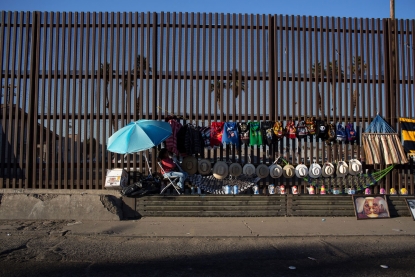 Street vendors use the border fence as a shelf to display their wares in Mexicali, February 14, 2017.
(AFP / Guillermo Arias)
Street vendors use the border fence as a shelf to display their wares in Mexicali, February 14, 2017.
(AFP / Guillermo Arias)Guillermo: Usually whenever I got to a place, I talk to the locals, in order to let the people know that I’m there and what I’m doing. It’s very important not to send the wrong message because if you do, these guys don’t fool around, you can end up dead. Usually you need a few days to gain some trust so that you can work in peace.
But on this particular project we didn’t have that luxury of time. It was very fast -- because I was shadowing Jim on the other side, in some places we were lucky if had just a few hours to shoot. I was very worried about that, to tell you the truth. Fortunately, I didn’t get into too much trouble.
That said, halfway through the trip, in Nogales, I had one of the scariest incidents that I’ve ever had as a reporter.
Guillermo: I was taking pictures on International Street, which is right on the border, late in the evening. There were some paintings on the wall that I thought could be interesting. It was an area where Border Patrol had shot a 16-year-old boy in 2012. And a few months ago, local television aired images that showed people smuggling drugs in the area. I think that put them -- the guys who control that particular territory -- into a ‘we don’t like the media’ type of mood. Most of the time, there are lots of things that are going on in the background that you’re not aware of. Which is why you have to be so careful and it’s important to develop contacts and trust beforehand.
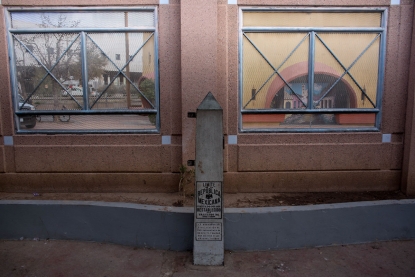 Nogales, Arizona, is seen through the border fence at Nogales, Mexico, on February 17, 2017. (AFP / Guillermo Arias)
Nogales, Arizona, is seen through the border fence at Nogales, Mexico, on February 17, 2017. (AFP / Guillermo Arias)As I was shooting, a big blue truck with tinted windows stopped not far from me. I heard its tires screeching. It just stopped. I couldn’t see anything inside because of the tinted windows. Noone got out. I took my last picture and I started walking slowly to my car. When I moved, the truck started following me. I stopped to take another picture. The truck left.
Then I saw another car, an SUV with tinted windows, stop at a nearby corner with its lights on. I took another picture and decided it was time to go back to the hotel. I drove super slowly, at about 10 kilometres an hour. The car followed me. I drove that slowly for two reasons. First, if it was just anyone, they would get frustrated and pass me. But when someone follows you at 10 kilometers an hour for 15 blocks, you know that he is really following you. Secondly, it’s very important not to run in these types of situations because as soon as you start running, you become prey.
Eventually the car left. They had let me go. But it was a pretty clear message -- ‘we are following you and we are watching you.”
It has been a long time since I experienced something similar and to tell you the truth it unnerved me. Most of the time, they send someone to warn you. That’s much easier, because you have a person in front of you with whom you can interact. You can explain what you are doing and you can ask what you shouldn’t do in order to avoid trouble. But this. This was truly scary.
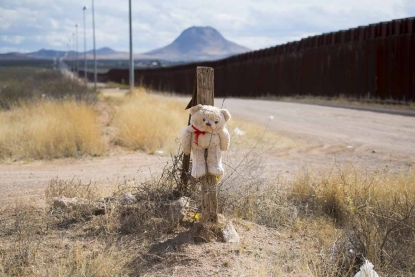 A teddy bear is tied to a post with barbed wire next tot he border fence in Douglas, Arizona, on February 18, 2017, on the US/Mexico border.
(AFP / Jim Watson)
A teddy bear is tied to a post with barbed wire next tot he border fence in Douglas, Arizona, on February 18, 2017, on the US/Mexico border.
(AFP / Jim Watson)After that, I spoke with a local reporter and I decided to do most of the driving on the US side and to cross into Mexico to simply take pictures for the project. I remember as I crossed from Nogales and started driving toward Douglas, Arizona, a feeling of rage grabbed hold of me.
I was so angry that I felt more secure on the US side than in Mexico. It was both incredibly outrageous and sad. How is that possible, I thought. Mexico is a great country with great people, but we have been jailed, criminals have taken our country, have hijacked it.
Guillermo: The general sentiment that I found along the border was that people and drugs will keep crossing the border, with or without a wall, be it above or below. I’ve been working on the border for years and many things have changed in that time -- more barriers, bigger fences, more law enforcement agents, less migrants, more narcos. What hasn’t changed much are the daily interactions between the border communities. Cities that lie on either side of the frontier are dependent on each other, be it the thousands of people from Tijuana who commute every day to work in San Diego or the crowds of elderly Americans in downtown Algodones seeking a cheaper dentist.
For the Mexican communities along the border, the most important security issue is the drug trafficking that’s taking place, the flow of drugs into the US and all the consequences that result from this, first and foremost the violence and the lack of security.
Yuri: From the Mexican side, you can see the strong presence of the US Border Patrol agents, be it vehicles, cameras or security systems. It looks very controlled from outside.
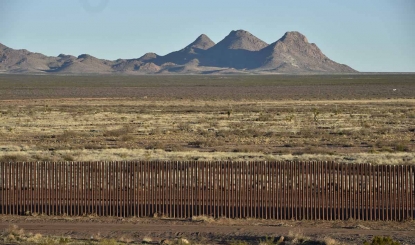 The border fence in Puerto Palomas, Mexico, February 19, 2017.
(AFP / Yuri Cortez)
The border fence in Puerto Palomas, Mexico, February 19, 2017.
(AFP / Yuri Cortez)Guillermo: The real ‘bad hombres,’ as President Trump likes to say, do not cross the border and risk being detained in the US. They stay on the Mexican side, in their realms of luxury and impunity, from where they send drugs to where the demand for those drugs lies -- the world’s largest drug consumer, USA. Some of the drugs cross through fences, but much of them are also smuggled through the border ports. Some are carried on the backs of the people crossing the desert on foot, but they are also transported by “honorable” American citizens going back into their country.
Most of the Border Patrol officers that I talked to don’t think a wall is necessary, but would rather have a boost in their numbers, a human wall if you will. In many place you have natural barriers, like the river or mountains so a physical barrier is not needed. And in many places, a barrier is not necessary because you need two-three days of walking to get to a village. Border Patrol just waits for them to get there and catches them there.
When you travel along the border on the Mexican side, one of the things that jumps out at you are the thousands of American citizens who cross into Mexico to buy medicine or to receive medical care that is too expensive for them in their own country. For example, in downtown Algodones, you see scores of mostly elderly Americans visiting the dentist and buying prescription drugs that are so much cheaper on this side of the border.
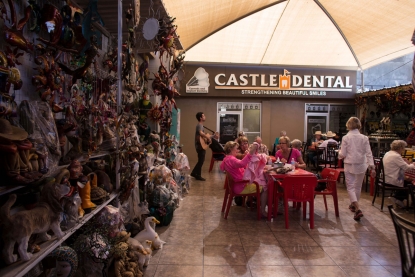 Visitors from the United States sit near a souvenir stand and a dental clinic in downtown Los Algodones, Mexico, February 15, 2017.
(AFP / Guillermo Arias)
Visitors from the United States sit near a souvenir stand and a dental clinic in downtown Los Algodones, Mexico, February 15, 2017.
(AFP / Guillermo Arias)You find that many -- I would say the bulk -- of Mexicans living along the border are not interested in moving to the United States. Like Hector Munoz Zaragoza, a middle-aged security guard in Agua Prieta. He came to the town two years ago, after helping to transport some cattle and has no interest in even crossing into the US.
You meet lots of people who have been deported from the US. Like Luis Manuel Testa, who was deported in September 2016 and now lives in Nogales. He had lived in the US for 32 years and doesn’t want to go back to Acapulco, where he was born, since his family remains in the US. Since being deported he has tried to cross back again several times, but without success.
Or Junior Rodriguez, who, after his third drunk driving arrest, was deported in 2011 under President Obama after having lived in the US for 31 years. He decided to stay in Tijuana to remain close to his family living in California.
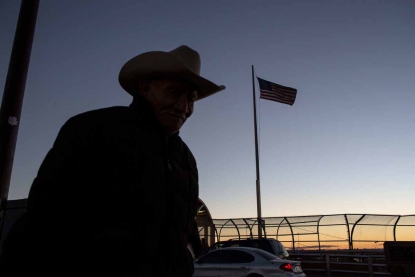 A man walks to Mexico at El Paso del Norte International Bridge on the US/Mexico border in Ciudad Juarez, on February 20, 2017, in northwestern Mexico.
(AFP / Guillermo Arias)
A man walks to Mexico at El Paso del Norte International Bridge on the US/Mexico border in Ciudad Juarez, on February 20, 2017, in northwestern Mexico.
(AFP / Guillermo Arias) 84 year old Trinidad sits at a plaza on the US/Mexico border in Piedras Negras on February 21, 2017 northern Mexico.
(AFP / Guillermo Arias)
84 year old Trinidad sits at a plaza on the US/Mexico border in Piedras Negras on February 21, 2017 northern Mexico.
(AFP / Guillermo Arias)
Sometimes you meet the unexpected. A waitress in Puerto Palomas told me that after she lost two babies during childbirth, she received medical treatment in the US for her third pregnancy, and ended up giving birth to a healthy baby girl. She comes from a very nationalist family, and her daughter is the only family member born in the US.
Sometimes you get a refreshing breath of normality. Like on Day 8 in Ojinaga, when we met two teenagers. Seventeen-year-old Abraham Vazquez, an aspiring singer, was being recorded by his friend Jose Chacon, 15, with a telephone. It was so refreshing to have met them, singing songs on the Rio Bravo. It was a slice of daily life outside of politics, migration, and the drug trade. Just normal daily life.
Guillermo: Aside from the politics, this trip was great because I got to show some of the raw natural beauty of the area. I especially love the desert. It’s amazing, you find sand, cacti, mountains. I just love the landscape. It’s not just one image, it’s a series of images that you see when you’re here that stick with you long after.
Yuri: We tried to show other things than the issue of immigration. To reflect some of the incredible beauty that you find here. The rivers, the bridges. We took some pictures with drones, which showed more than what we normally show.
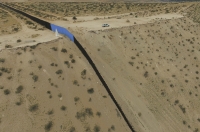
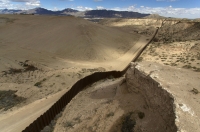
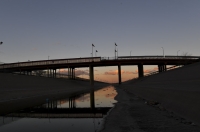

Guillermo: One of the things that I found really creepy was in a little town of Altar. Back in the 1990s and early 2000s it used to be the biggest migrant town. Then the narcos came and just took over the control of the routes to the desert. In downtown Altar, they have all these little stores, where they sell all this stuff for migrants. The first time I went there in 2004, the stores surrounding the main plaza were packed with migrants and selling backpacks, water bottles, trekking gear.
But now, all you see is camouflage gear. You don’t see migrants hanging around the main plaza. It really brought home to me how things have changed. Before you had people crossing the desert trying to get into the US. Now you have narcos controlling the area and you have people who are forced to cross with drugs. These people have been shown on hidden cameras, walking across the desert with these huge backpacks filled with drugs. The migrants have no choice.
To others, that picture of camouflage gear may seem pretty harmless. But to me it was really scary -- it really showed how the issue has changed, it’s not so much about migration anymore than about drug smuggling.
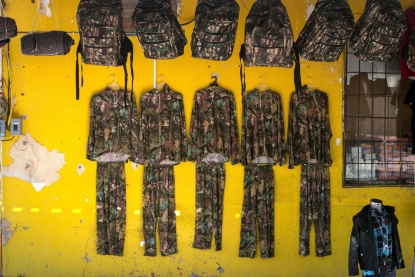 Backpacks and camouflage clothing for sale at a shop in Altar in Mexico, on February 16, 2017. (AFP / Guillermo Arias)
Backpacks and camouflage clothing for sale at a shop in Altar in Mexico, on February 16, 2017. (AFP / Guillermo Arias)Guillermo: The craziest thing that we saw was near Ojinaga. We were driving and we noticed something by the river.
Yuri: At first I thought it was someone fishing. Then we got closer I could see that it’s a girl.
I realized that she was walking with her baby to cross the river.
Guillermo: We stopped the car and tried not to make a big deal about it. We didn’t want to draw attention to her or put her on the spot. The light was gone and suddenly she just jumped into the water and started walking across. With the baby in her arms. We didn’t approach, because we also didn’t want to scare her and make her drop the baby.
Yuri: It was unbelievable. She was walking very sure, step by step. How many people die trying to cross the river. And she is just calmly taking step after step, with a baby in her arms. I just thought that she was crazy. I had never seen anything like that before.
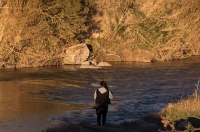
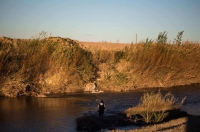
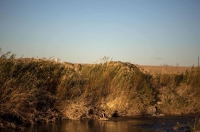
Guillermo: At some point I was more worried about her dropping the baby than I was about taking pictures. I tried to keep the moment as it was, without interfering. It was really hard for me. Fifteen years ago, I would have just jumped into the river with a wide angle lens and started snapping away. But now, I realized that I was more worried about exposing her and frightening her than anything else. Maybe I’m getting older.
It was the craziest thing that I saw during this project. You just don’t expect to see a woman jump into a river by herself with a baby in her arms and cross to the other side.
This blog was written with Yana Dlugy in Paris.



